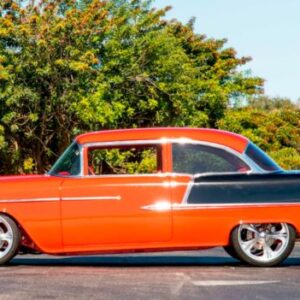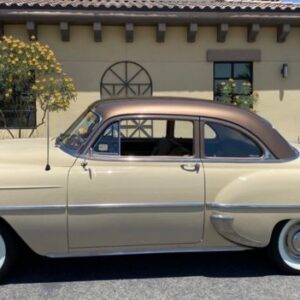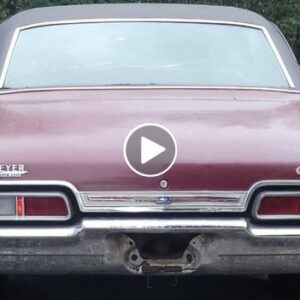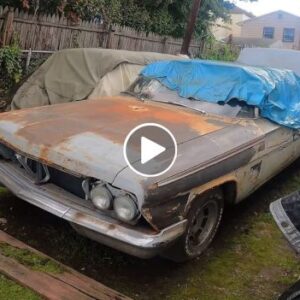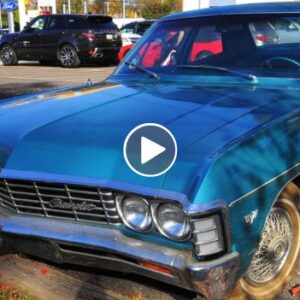The 1969 Pontiac Firebird is an iconic American muscle car that has captured the imaginations of car enthusiasts for generations. With its sleek design, powerful engine options, and enduring appeal, it’s no wonder that this classic car continues to be a sought-after collector’s item.
-1686819378x1024.jpg)
In this article, we’ll delve into the history, design, and features of the 1969 Firebird, exploring what makes this Pontiac model so special.
1. A Brief History of the Pontiac Firebird
The Pontiac Firebird was first introduced in 1967 as a competitor to the Ford Mustang and the Chevrolet Camaro. Designed to capitalize on the growing popularity of pony cars, the Firebird combined sporty styling and performance with the luxury and comfort that Pontiac was known for. Over the years, the Firebird underwent several design changes and updates, culminating in the 1969 model, which many consider to be one of the most attractive and desirable iterations of the car.
-1686819552.jpg)
2. Design
The 1969 Pontiac Firebird was an iconic American muscle car known for its aggressive styling and powerful performance. Here are some key design features of the 1969 Firebird:
Exterior Design
The Firebird had a distinctive and muscular appearance. It featured a long, sleek hood with a prominent twin-scoop design and a wide, aggressive front grille. The headlights were recessed and integrated into the grille, giving the car a fierce look. The bodylines were clean and well-defined, with sculpted fenders and a sloping roofline that flowed into a short decklid.
-1686819566x1024.jpg)
Front End
The front end of the Firebird was characterized by its split front grille, which consisted of a horizontal bar dividing the grille into two sections. The iconic Pontiac arrowhead logo was displayed prominently in the center. The grille was flanked by quad headlights, with the outer lights positioned slightly lower than the inner ones.
Rear End
The rear of the Firebird featured a distinctive split bumper design with vertical taillights positioned on either side. The taillights had a horizontal chrome strip running through them, adding to the car’s visual appeal. The rear spoiler was an optional feature that enhanced the car’s aerodynamics.
-1686819582.jpg)
Body Options
The Firebird was available in two body styles: a two-door coupe and a convertible. The coupe had a sleek, hardtop design, while the convertible featured a power-operated soft top that could be lowered for open-air driving.
Interior
The interior of the 1969 Firebird was designed with a driver-focused layout. It featured a sporty and functional dashboard with a range of gauges and controls. The seats were comfortable and supportive, with optional bucket seats available for enhanced sportiness. The center console housed the shifter and additional controls.
-1686819615.jpg)
3. Engine and Performance
The 1969 Pontiac Firebird was available with several engine options, ranging from inline-six to V8 configurations. Here are some of the engines that were offered for the 1969 Firebird:
The base engine was a 230 cubic-inch (3.8-liter) inline-six engine, which produced around 165 horsepower. A step up from the base engine was a 250 cubic-inch (4.1-liter) inline-six engine, which generated approximately 175 horsepower.
-1686819633.jpg)
One of the popular V8 options was the 350 cubic-inch (5.7-liter) V8 engine, available in several variants. The standard 350 V8 produced around 265 horsepower, but there were higher-performance versions available as well.
Another V8 option was the 400 cubic-inch (6.6-liter) V8 engine, which came in various power outputs. The standard version produced approximately 330 horsepower, but there were also high-performance variants available, such as the Ram Air III and Ram Air IV engines.
-1686819645.jpg)
At the top of the performance range was the legendary 400 cubic-inch (6.6-liter) V8 engine known as the Pontiac 455, which was available in the Firebird Trans Am. The 455 engine produced around 335 horsepower and was renowned for its performance.
4. Transmission Options
To complement the powerful engines, the 1969 Pontiac Firebird was available with several transmission options. Buyers could choose between a three-speed manual, a four-speed manual, or a three-speed automatic transmission. The four-speed manual was a popular choice for those seeking a sporty, engaging driving experience, while the automatic transmission offered greater convenience and ease of use.
-1686819656.jpg)
The actual performance of the Firebird varied depending on the engine, transmission, and other factors. The higher-performance engines provided impressive acceleration and speed, making the Firebird a popular choice among muscle car enthusiasts.
5. Sales and Production
The 1969 Pontiac Firebird enjoyed substantial sales figures as one of the premier muscle cars of its time. During the 1969 production year, Pontiac produced a total of approximately 87,708 Firebird units, including all models and variants. These sales figures allowed the Firebird to maintain its status as a popular and competitive option in the pony car market.
Here’s a breakdown of the production numbers for the various 1969 Firebird models:
Firebird Base Model
Pontiac produced 65,008 units of the base model Firebird, which came with the inline-six engine as standard and offered the option to upgrade to the 350-cubic inch V8.
Firebird 350
The Firebird 350, featuring the 350-cubic inch V8 engine, had a production run of 11,649 units.
Firebird 400
The top-of-the-line Firebird 400, equipped with the 400-cubic inch V8 engine, saw a production of 8,745 units.
-1686819444x1024.jpg)
Firebird Trans Am
The limited-production Trans Am model, which was introduced mid-year in March 1969, had a production run of only 697 units. Among these, 689 were hardtop coupes, and 8 were convertibles. This rarity has made the 1969 Firebird Trans Am particularly sought-after among collectors today.
Despite strong sales figures, the 1969 Pontiac Firebird was still outsold by its main competitors, the Ford Mustang and Chevrolet Camaro. However, the Firebird’s enduring appeal and distinctive design have ensured its lasting impact on the muscle car scene and its status as an iconic American classic.
The 1969 Pontiac Firebird Trans Am: The Ultimate Performance Package
For drivers seeking the pinnacle of performance and style, the 1969 Pontiac Firebird Trans Am was the top choice. Introduced in March 1969, the Trans Am package included a number of enhancements, such as upgraded suspension components, power front disc brakes, and distinctive Trans Am badging on the exterior of the car. Additionally, all Trans Am models came standard with the powerful 335-horsepower 400-cubic inch V8 engine, with the option to upgrade to the even more potent Ram Air IV version.
The Trans Am also featured a unique design, with a white exterior, blue racing stripes, and special wheel covers that set it apart from the standard Firebird models. These design elements, combined with the impressive performance capabilities, made the 1969 Firebird Trans Am a highly sought-after muscle car, both in its time and among collectors today.
6. Market Reception
The 1969 Pontiac Firebird was generally well-received by the market and played a significant role in Pontiac’s success during that era. Here are some key factors that contributed to its positive market reception:
Variety of options
Pontiac offered a wide array of options and packages for the Firebird, allowing buyers to customize their cars to suit their individual preferences. This flexibility appealed to a broad range of customers and helped the Firebird stand out among its competitors.
Competitive pricing
The Firebird was positioned as a more affordable alternative to the higher-priced muscle cars of the time, making it an attractive option for performance enthusiasts on a budget.
Popularity of the muscle car segment
The late 1960s marked the peak of the muscle car era, with strong demand for high-performance vehicles. The Firebird’s combination of style, power, and affordability made it well-positioned to capitalize on this trend and attract a significant market share.
Overall, the 1969 Pontiac Firebird received positive market reception due to its attractive design, powerful performance, customization options, and competitive pricing. These factors contributed to its popularity and established the Firebird as an iconic American muscle car.
7. Cultural Values
The 1969 Pontiac Firebird, like many classic cars, holds cultural values that reflect the time period and the ideals of its era. Here are some cultural values associated with the 1969 Pontiac Firebird:
American Muscle
The Firebird represented the essence of American muscle cars, embodying power, speed, and performance. It symbolized the freedom and spirit of the open road, capturing the adventurous and rebellious nature often associated with the 1960s and 1970s.
-1686819758x1024.jpg)
Individuality and Personalization
The Firebird allowed owners to customize their vehicles, reflecting the cultural value of individuality and self-expression. Owners could choose from various trim levels, engines, and options, allowing them to create a personalized driving experience that aligned with their tastes and preferences.
Youth Culture
The Firebird appealed to the younger generation, particularly those who were seeking a sense of excitement and a break from tradition. It represented the spirit of youth culture, capturing the desire for freedom, speed, and independence.
Automotive Enthusiasm
The Firebird was part of a broader enthusiasm for automobiles during that time. The culture of modifying and racing cars was prominent, with car enthusiasts showcasing their vehicles, participating in drag races, and attending car shows. The Firebird was often seen as a canvas for customization and performance enhancements, reflecting the passion and pride that many car enthusiasts held for their vehicles.
-1686819737.jpg)
Nostalgia and Collector’s Value
Over the years, the 1969 Pontiac Firebird has gained significant nostalgic and collector’s value. It has become an iconic symbol of a bygone era, evoking a sense of nostalgia for enthusiasts and collectors who appreciate its design, performance, and cultural significance.
These cultural values associated with the 1969 Pontiac Firebird have contributed to its enduring popularity and its status as a classic car that continues to capture the imagination of automotive enthusiasts today.
8. Maintenance and Restoration Tips for 1969 Pontiac Firebirds
Maintaining and restoring a 1969 Pontiac Firebird can be a labor of love for dedicated car enthusiasts. Here are some tips to help you keep your classic car in top condition:
Regular maintenance
Like any vehicle, regular maintenance is essential for keeping your Firebird running smoothly. This includes changing the oil and oil filter, checking and replacing spark plugs, and inspecting belts and hoses for wear.
-1686819785x1024.jpg)
Proper storage
To preserve the condition of your Firebird, it’s crucial to store it in a dry, climate-controlled environment. This will help prevent rust and damage caused by moisture and temperature fluctuations.
Use quality parts
When repairing or restoring your 1969 Pontiac Firebird, it’s important to use high-quality parts that meet or exceed OEM specifications. This will help ensure the longevity and performance of your classic car.
Join a car club or online forum
Connecting with fellow Firebird enthusiasts can be a valuable resource for information, advice, and camaraderie. Share your experiences, learn from others, and enjoy the camaraderie of fellow classic car lovers.
-1686819800x1024.jpg)
Invest in proper tools and equipment
Having the right tools and equipment can make all the difference when working on your classic car. Invest in quality tools and equipment to make maintenance and restoration tasks more manageable and efficient.
Be patient and persistent
Restoring a classic car like the 1969 Pontiac Firebird can be a time-consuming and challenging process. Be prepared to invest time, effort, and money into your project, and remember that patience and persistence are key to achieving the best results.

